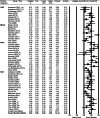Two decades of digital interventions for anxiety disorders: a systematic review and meta-analysis of treatment effectiveness
- PMID: 34047264
- PMCID: PMC9899576
- DOI: 10.1017/S0033291721001999
Two decades of digital interventions for anxiety disorders: a systematic review and meta-analysis of treatment effectiveness
Abstract
Background: Digital interventions for anxiety disorders are a promising solution to address barriers to evidence-based treatment access. Precise and powerful estimates of digital intervention effectiveness for anxiety disorders are necessary for further adoption in practice. The present systematic review and meta-analysis examined the effectiveness of digital interventions across all anxiety disorders and specific to each disorder v. wait-list and care-as-usual controls.
Methods: A systematic search of bibliographic databases identified 15 030 abstracts from inception to 1 January 2020. Forty-seven randomized controlled trials (53 comparisons; 4958 participants) contributed to the meta-analysis. Subgroup analyses were conducted by an anxiety disorder, risk of bias, treatment support, recruitment, location and treatment adherence.
Results: A large, pooled effect size of g = 0.80 [95% Confidence Interval: 0.68-0.93] was found in favor of digital interventions. Moderate to large pooled effect sizes favoring digital interventions were found for generalized anxiety disorder (g = 0.62), mixed anxiety samples (g = 0.68), panic disorder with or without agoraphobia (g = 1.08) and social anxiety disorder (g = 0.76) subgroups. No subgroups were significantly different or related to the pooled effect size. Notably, the effects of guided interventions (g = 0.84) and unguided interventions (g = 0.64) were not significantly different. Supplemental analysis comparing digital and face-to-face interventions (9 comparisons; 683 participants) found no significant difference in effect [g = 0.14 favoring digital interventions; Confidence Interval: -0.01 to 0.30].
Conclusion: The precise and powerful estimates found further justify the application of digital interventions for anxiety disorders in place of wait-list or usual care.
Keywords: Anxiety disorders; digital interventions; effect size; effectiveness; meta-analysis.
Figures
Similar articles
-
Internet-Delivered Cognitive Behavioural Therapy for Major Depression and Anxiety Disorders: A Health Technology Assessment.Ont Health Technol Assess Ser. 2019 Feb 19;19(6):1-199. eCollection 2019. Ont Health Technol Assess Ser. 2019. PMID: 30873251 Free PMC article.
-
Long-term Outcomes of Cognitive Behavioral Therapy for Anxiety-Related Disorders: A Systematic Review and Meta-analysis.JAMA Psychiatry. 2020 Mar 1;77(3):265-273. doi: 10.1001/jamapsychiatry.2019.3986. JAMA Psychiatry. 2020. PMID: 31758858 Free PMC article.
-
Psychological interventions for improving adherence to inhaled therapies in people with cystic fibrosis.Cochrane Database Syst Rev. 2023 Mar 29;3(3):CD013766. doi: 10.1002/14651858.CD013766.pub2. Cochrane Database Syst Rev. 2023. PMID: 36989170 Free PMC article. Review.
-
Impact of summer programmes on the outcomes of disadvantaged or 'at risk' young people: A systematic review.Campbell Syst Rev. 2024 Jun 13;20(2):e1406. doi: 10.1002/cl2.1406. eCollection 2024 Jun. Campbell Syst Rev. 2024. PMID: 38873396 Free PMC article. Review.
-
Telephone interventions for symptom management in adults with cancer.Cochrane Database Syst Rev. 2020 Jun 2;6(6):CD007568. doi: 10.1002/14651858.CD007568.pub2. Cochrane Database Syst Rev. 2020. PMID: 32483832 Free PMC article.
Cited by
-
Commentary: The psychological and social impact of COVID-19: New perspectives of well-being.Front Psychol. 2022 Sep 23;13:953147. doi: 10.3389/fpsyg.2022.953147. eCollection 2022. Front Psychol. 2022. PMID: 36211845 Free PMC article. No abstract available.
-
Views of German mental health professionals on the use of digital mental health interventions for eating disorders: a qualitative interview study.J Eat Disord. 2024 Feb 23;12(1):32. doi: 10.1186/s40337-024-00978-1. J Eat Disord. 2024. PMID: 38395950 Free PMC article.
-
Evaluation of the Use of Digital Mental Health Platforms and Interventions: Scoping Review.Int J Environ Res Public Health. 2022 Dec 26;20(1):362. doi: 10.3390/ijerph20010362. Int J Environ Res Public Health. 2022. PMID: 36612685 Free PMC article.
-
Engagement With an Internet-Administered, Guided, Low-Intensity Cognitive Behavioral Therapy Intervention for Parents of Children Treated for Cancer: Analysis of Log-Data From the ENGAGE Feasibility Trial.JMIR Form Res. 2025 Jan 28;9:e67171. doi: 10.2196/67171. JMIR Form Res. 2025. PMID: 39874575 Free PMC article.
-
The Journey From Nonimmersive to Immersive Multiuser Applications in Mental Health Care: Systematic Review.J Med Internet Res. 2024 Nov 7;26:e60441. doi: 10.2196/60441. J Med Internet Res. 2024. PMID: 39509153 Free PMC article.
References
-
- Allen, A. R., Newby, J. M., Mackenzie, A., Smith, J., Boulton, M., Loughnan, S. A., & Andrews, G. (2016). Internet cognitive-behavioural treatment for panic disorder: Randomised controlled trial and evidence of effectiveness in primary care. BJPsych Open, 2(2), 154–162. doi: 10.1192/bjpo.bp.115.001826. - DOI - PMC - PubMed
-
- American Psychiatric, A. (2013). Diagnostic and statistical manual of mental disorders: DSM-5 (5th ed.). Arlington, VA, Washington, D.C.: American Psychiatric Association.
-
- Andersson, G., Carlbring, P., Holmstrom, A., Sparthan, E., Furmark, T., Nilsson-Ihrfelt, E., … Ekselius, L. (2006). Internet-based self-help with therapist feedback and in vivo group exposure for social phobia: A randomized controlled trial. Journal of Consulting and Clinical Psychology, 74(4), 677–686. doi: 10.1037/0022-006x.74.4.677. - DOI - PubMed
-
- Andrews, G., Basu, A., Cuijpers, P., Craske, M. G., McEvoy, P., English, C. L., & Newby, J. M. (2018). Computer therapy for the anxiety and depression disorders is effective, acceptable and practical health care: An updated meta-analysis. Journal of Anxiety Disorders, 55, 70–78. doi: 10.1016/j.janxdis.2018.01.001. - DOI - PubMed
Publication types
MeSH terms
LinkOut - more resources
Full Text Sources
Other Literature Sources
Medical



